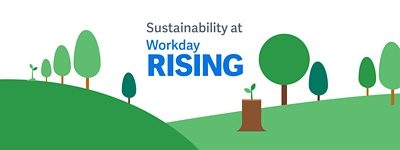At Workday, we think about sustainability in everything we do and measure our success not only in financial terms but also in how we impact the world. Guided by our core values, we’re committed to creating a sustainable future and know we’re stronger when we work together with our community. Through collaboration, we can make a greater impact.
At Workday Rising, we have sustainability throughout the full program, including our registration, expo builds, transportation, etc. We’re committed to creating experiences aligned with our pillars of sustainability: measuring carbon impact, partnering with sustainable supply chains, reducing our waste, and engaging with the Workday Rising community.
Committing to Carbon Reduction
As we’ve done since Workday Rising in 2018, we’re proud to share that we’ll once again be offsetting emissions from travel not only for Workday employee travel to Workday Rising, but all attendee travel. We’ll do this by purchasing high-quality carbon credits that support sustainable development projects around the world. By limiting on-site travel to only essential needs, we’re taking a strategic approach to travel. In addition, Workday Rising attendees will be able to view a robust library of content remotely and be able to view recorded sessions post-event.
For on-site transportation, attendees are encouraged to ride the provided fuel- efficient shuttles to reduce traffic congestion between hotels and the convention center. The routes are designed to maximize ridership and minimize the number of shuttles on the road, lessening environmental impact. In addition, we’ve increased the number of hotel rooms for attendees within walking distance of the convention center, further eliminating the number of shuttles needed.
Calculating Carbon Emissions With TRACE: How We’ll Measure Our Impact
We’ll gather data from our vendors at Workday Rising across key areas to develop a per-person carbon footprint. Using a carbon emission measurement tool specifically for large events—TRACE by isla—we’ll create a baseline this year for future event measurement. By collecting data on energy, water usage, food, beverage, travel, graphics, building materials, transportation, waste, and recycling, we’ll be able to evaluate total carbon emissions. We’ll incorporate this data into future event planning and share our post-show outcomes.











